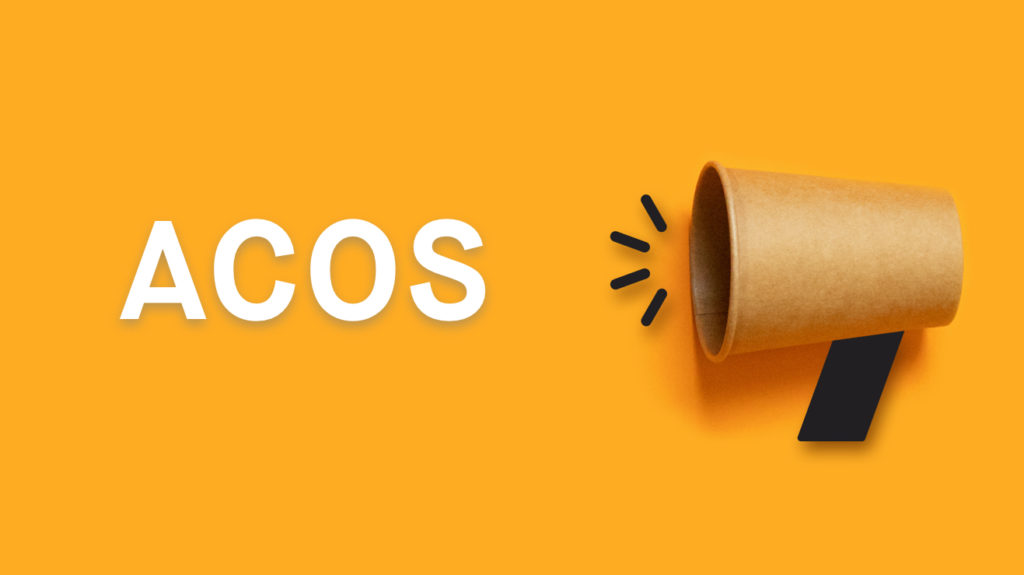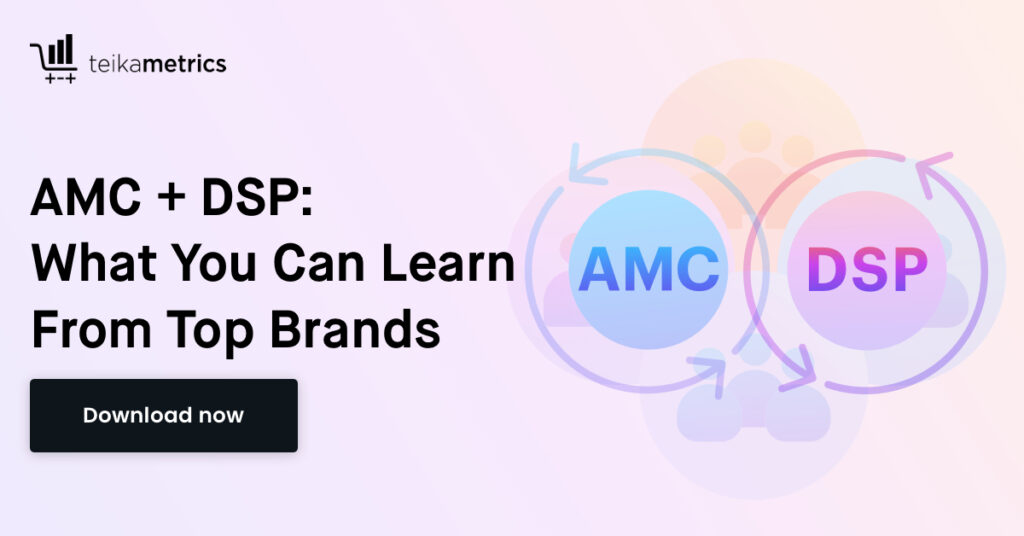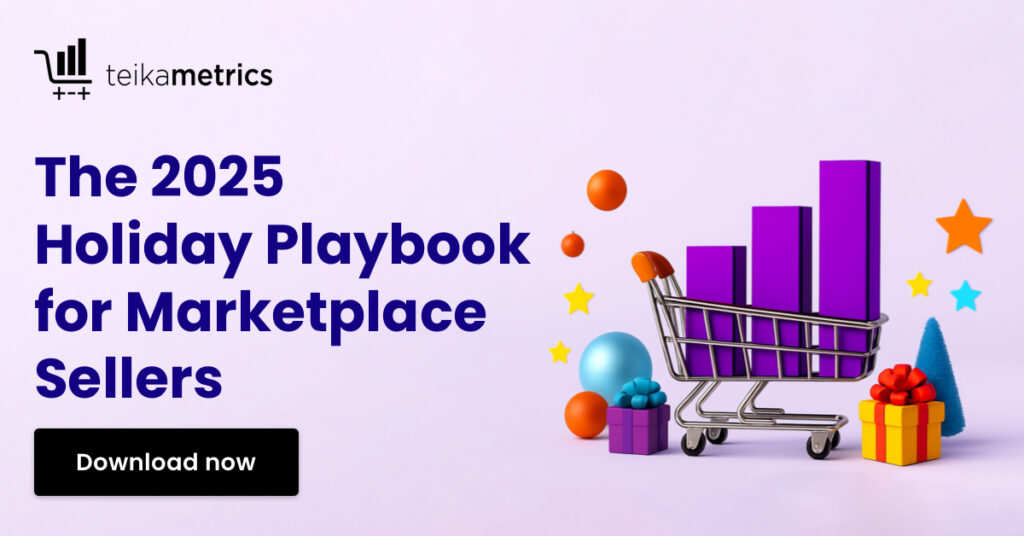Most brands and sellers on Amazon fundamentally misapply the concept of ACOS as a metric to accurately measure the success of their Amazon advertising.
It became crystal clear to me when I started using Teikametrics software to manage some of my clients’ Amazon ad accounts that ACOS isn’t always the most important metric for advertising. The software clearly exposes TACOS as well as ACOS, which viewed together make it easier to see the real impact of advertising across a business.
In this article, I’ll break down some definitions around Amazon advertising, the different types of goals and strategies that can be employed, and how to measure success.
Defining Terms & Concepts
To begin, let’s get some definitions out of the way, just so we’re all on the same page…
ACoS is your Advertising Cost of Sale. This is determined by dividing the ad spend by the gross revenue attributed to that ad spend for a particular keyword or campaign.
The reason most sellers use ACOS as a primary metric of the efficacy of their campaigns and advertising is that it’s the simplest to calculate and evaluate: I spent x dollars, and made x dollars in revenue. While it could generally be argued that a 6% ACOS was incredible, and 150% ACOS was a waste of money, the actual specifics of the product, strategy and goal of each company makes this a bit more complex.
Remember that ACOS can be easily manipulated by simply adjusting your bid, and therefore your cost per click. On average, your conversion rate for a specific keyword will remain consistent, so if you typically convert 1 out of 10 customers, you can decrease your ACOS by half, simply by cutting your bid to half of your current cost-per-click. Of course, this will inherently decrease your overall sales, as cutting your bid can move your ad from the top of page 1, to the middle of page 3 with much less visibility.
This brings us to our next concept that is actually a better metric to keep in mind when advertising.
TACOS is your Total Advertising Cost of Sale. This is determined by dividing ad spend by the gross revenue of all products, including the organic sales not attributed to advertising.
To understand why the second metric is important, it’s important to understand the Amazon Trifecta.

Discoverability has to do with the specific SEO Keywords relevant to your product. Typically these keywords should be integrated into your listing so that they are indexed by Amazon’s A9 search algorithm.
Buyability is how well optimized your products are to convert for the relevant keywords determined in discoverability. Things like high quality images and well-planned bullets can help with buyability.
Rankability is the result of Discoverability + Buyability. As customers search these relevant terms and purchase your product, then your product over time will organically rank higher for that search term.
The key takeaway here is that advertising on specific search terms directly impacts your product’s organic rank and sales for those same search terms.
Keep in mind that the top 3 products for any given search term achieve a majority of all clicks and sales, so simply improving your organic rank doesn’t drive an immediate increase in organic sales, but it does help.
Defining Your Strategy
All Amazon Advertising comes down to having a specific strategy and then being able to execute that strategy. There is no one-size fits all. A strategy that works for one brand, may not work for another. Ad metrics that one seller considers a huge success, may be considered a colossal failure by another. In this section I’ll define some of the primary strategies and goals that sellers might employ at different times in their Amazon journey.
Launch – It should be noted that launching a product is one of the most difficult elements. Referred to as a “cold start” it needs to be understood that there is a learning process, both on the Amazon and seller side respectively. It will take time for Amazon’s algorithm to learn which terms your product converts best for and which ads to show, and when. In addition, if your product has zero reviews when you start, it won’t convert as well for the same exact keywords as when you have some initial product reviews, so take that into consideration when mapping out your strategy.
Similarly, it’s an investment to discover which researched search terms convert best for which products. Based on your budget and goals, you can either start slowly, adding small batches of keywords and campaigns and then steadily increasing bids in order to test the waters. Conversely, you can start high and go fast, bidding high on hundreds or thousands of terms in order to quickly learn which keywords generate revenue and which ones don’t, but at a significantly greater cost. It all depends on your goal.
Grow – Growth is typically a goal of any brand or seller on Amazon, which largely entails researching and bidding on the unbranded, generic keywords that describe your product. Depending on the category, approximately 80% of all searches on Amazon are unbranded, where a customer knows the type of product they want to purchase, but hasn’t specified the specific brand that they prefer or desire in the search bar.
In many ways, growth is an extension of the launch phase. Continuing to discover new keyword terms to test, bidding on them, and then incorporating them into existing campaigns or creating new ones. In addition, with the numerous ad types that Amazon is deploying, it’s possible to place the same relevant keywords into a Sponsored Product campaign, a Sponsored Brand campaign as well as a Sponsored Brand Video campaign, all which have the ability to bring in and generate additional revenue.
Protect – Regardless of the size of the brand, it’s almost always imperative to bid on one’s own brand name and product line names in order to protect your brand from competitors. Protecting your brand can include Sponsored Brand and Sponsored Product ads for your best sellers, as well as video ads highlighting your top seller.
Taking this a step further (though it can get costly) is actually advertising your products on your other products using both Product Attribute Targeting and Sponsored Display. This takes up real estate on your own listings, while cross promoting your products, while making it more difficult, and more expensive, for competitors to advertise on your listings.
Factors Impacting Strategy
A few of the important things to consider when creating the strategy for your brand or product line are things that will be specific to you, and go beyond the metrics that Amazon readily provides you with. While often more difficult to track, it’s actually imperative to keep these elements in mind in order to create a strategy that makes sense.
Profitability – This is probably one of the most overlooked, yet crucial, factors that impact your strategy. How much are you actually putting in the bank at the end of the day once all of the dust has settled? For this reason, tracking your advertising spend, gross sales, Amazon fees and COGS is essential to understanding your true profitability, even as you scale your brand or business.
Customer Acquisition – In some cases brands are simply looking to acquire new customers. This can mean using advertising to build brand awareness, even if products are being purchased in stores. Since roughly 75% of all product searches start on Amazon, using advertising to get top of a search page can be valuable in order to drive brand awareness even if it does not directly impact your on-Amazon ROI.
Average Re-order – Consumables have a significant advantage over other CPG products, particularly if they have a short life cycle. In these instances, if you know that once a new customer buys your product, they are likely to re-order, and you’re able to maintain a high level of retention, you might be willing to spend significantly more on advertising to generate initial orders by new customers, knowing that the investment will pay off in the long run.
Levels of Aggressiveness
Amazon itself spent years selling products at a loss simply to gain market share, and while it could be argued as a dumb move for quite some time, it’s also hard to argue with the realization that Amazon now owns 50% of ALL ecommerce. Along the same lines, depending on the chosen strategy, the level of aggressiveness may vary brand to brand.
Brand Terms – Typically resulting in the lowest ACOS (depending on how well known your brand is, or how aggressive your competitors are) bidding on your brand name is usually the first type of campaign to be set up, in order to provide brand protection, as well as generate initial traffic to your listings. Just be aware that these sales are extremely unlikely to be incremental or be an engine for growth.
Unbranded Terms – As discussed in the Growth section above, unbranded terms will be the next level of advertising, usually representing your greatest opportunity for growth (though not always).
Competitor Terms – This is usually the most costly level of advertising, as you will be directly competing for your competitor’s customers who are actively searching for their product or brand. It is typically recommended that you make this your last phase, once you have fully exploited unbranded terms.
Typically the category determines the cost per click, and how aggressive the market is. In niche markets, the cost per click can be extremely low, but it still requires you to have a well optimized listing to convert for terms.
This variance in aggressiveness also provides a campaign structure to follow. It doesn’t make sense to put branded keywords with a low CPC that you convert well for, in the same campaign as competitor terms with high CPC’s that are more difficult to generate revenue for. For this reason, it’s best to separate keywords into groups based on how well those keywords convert and how aggressive the advertising is.
Capping a Budget – Remember that one of the benefits of grouping your keywords into separate campaigns is the ability to set a campaign level budget. This allows you to set a high or unlimited budget for brand protection, aggressive budgets for unbranded terms for growth, but more conservative budgets for competitor keywords.
While ACOS and TACOS can be helpful metrics to gauge some aspects of ad spend, they are by no means indicative of the profitability or sustainability of your brand or business. Having a specific advertising strategy that matches where you are, and is geared to help you achieve the growth and profitability you are looking for is the most important element to achieving the success you’re looking for on Amazon.
Shannon Roddy is an Amazon Expert, Speaker and the founder of Marketplace Seller Courses. He has consulted with over 120 clients to help them successfully launch, grow and protect their brands on the Amazon platform. In addition to creating Online Courses for brand owners, Shannon provides 1-on-1 Coaching for inventors, brands and agencies to leverage new opportunities on the Amazon platform.





